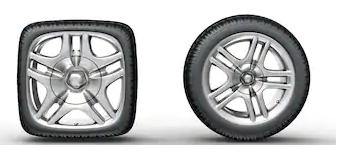I am trying to understand quite naively wheels in a specific framework.
Intro
We normally think of squares and circles as different concepts of shapes, but I am reframing it that both are polygons with equal sides. The difference being that a circle is a polygon with infinite equal sides and a square is a polygon with four equal sides.
So imagine you have a horse and cart. The cart and its weight is 100kg. The cart has two wheels. In the first case, the cart has square wheels, in the second case round wheels.
Let's say the horse pulls the cart over a distance which would make the square wheel do ten complete turns. Call that distance D.
Questions
1) The force that that horse has to pull with in order to make the cart move at a consistent speed across D with
A) the square wheel = polygon, equal sides, number of sides =4
B) the round wheel = = polygon, equal sides, number of sides = infinite
What would that formula be?
I'd like to know what the universal formula is, referencing the number of sides of the polygon.
Then in the case of the round wheel with its infinite sides, simplification of the formula would give I assume a more well-known formula for wheel motion (I don't know what this is)
(Intuitively, it's clear that there's a far greater load on the square wheel and that also if we were to plot the graph of the force that the horse needs to pull, it would be a maximum right when there is a transition to the side of the square being flat on the ground and it would be a minimum when the line between the center of the square and the corner of the square is 90 degrees to the ground surface. So I imagine the formula would give a wave, and the more/ less sides of the polygon, the more "intense" the wave.. as the number of sides tends to infinity- ie. the wheel is more circular in shape- the wave would dampen to be an absolute number).
Guidance would be greatly appreciated!).
2) For the above, what the relation to the required maximal axle load? Conceptually and /or formulaically.
(I'd be happy to know what the formula is but I'd really like to understand the concept better).
***Intuitively, it's clear that at any point the surface area of the wheel touching the ground- whether the wheel is a circle or square- is exactly the same.
NB I am not a physicist- I do understand mathematical concepts and high school physics. Having said that, I'd really be grateful for any explanation that is built ground up rather than quoting things like torque.
Thanks!***

